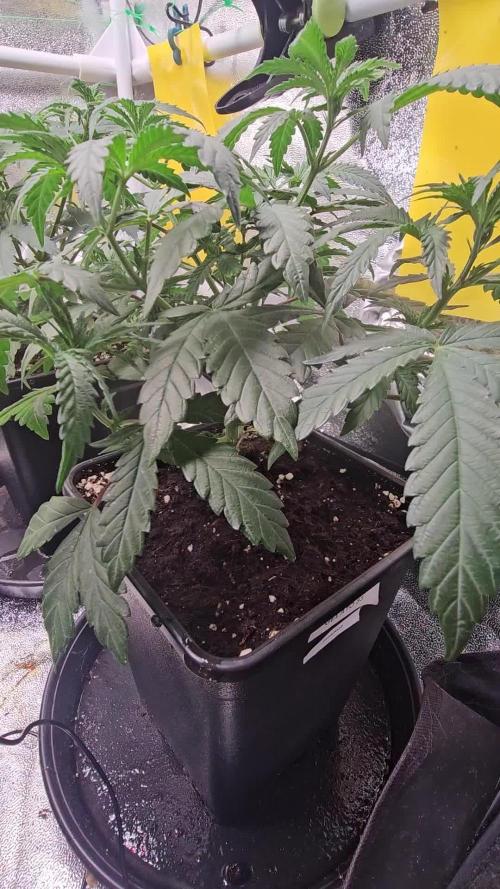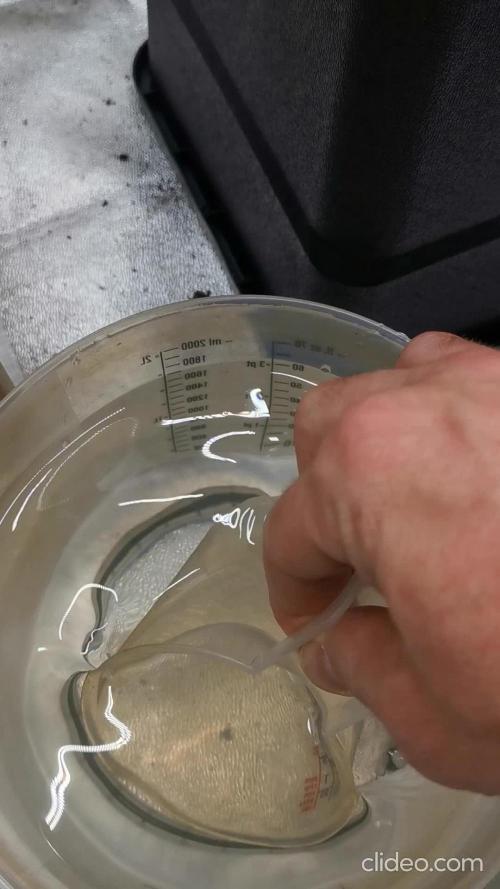By continuing to use the website or clicking Accept you consent to our cookies and personal data policy and confirm that you are at least 18 year old. For details please see Privacy Policy and Terms
Accept
Likes
Comments
Share


@MH_RDWC
Follow
Everything went well. Only added a little hydroguard, silica blast and water throughout the week. They’re getting a little fatter and a lot frostier.
Likes
64
Share


@Hempface86
Follow
Well, she is definitely getting there. She is extremely stinky. I'm starting to show some beautiful colors... When I open my front door this smells smacjs you right in the face and it is heavenly... Thank you so much to Kannabia Seeds i must say.I am happy then I take this over the rs11 because she is absolutely stunning. The nugs are rock and I mean rock hard, and like I said, this smell is top notch... I think she has about a week tops left and she is getting the chop ... I hope everyone is doing well, thank you to everybody. I really appreciate everyone showing support and understanding that it's nothing personal that I haven't been liking and talking as much... I am, however, coming around the hump, so I should be more active in the future... I hope always well God bless everyone ✌️
Likes
199
Share


@CRiSPrGrow
Follow
Do you see that SWAMPMONSTER in the corner of the tent there ?? The Queen towers above the canopy and the rest of the plants lol. It's really interesting from using the Smart Proteins, i think how they work is that the plant is able to process them and compensate any kind of slight deficiency which means that each plant that gets the proteins is able to grow to it's maximum potential and at the same time grow to its **individual** potential... that's why each of these plants has so much "character", because if you look closely it's less a question of phenotype but more like "individual expression".... INTERESTING !!! Anyway that's about the visual... my main concern about these is how loud they f-ing smell !!! ITS PROBLEMATIC, so be conscious of that if you plant to grow these one day ! REALLY REALLY LOUD, honestly there should be an additional category on GD like "problematic" which is beyond the "strong smell" category. I have two large carbon filters on two 1330m3/h fans and it's a problem. Hope you understand how unusual that is for a plant in veg lol... I think the smart protein probably affects how strong the plants smell because all the plants seem more smelly than expected... TBH i'll fix the smell issue but hopefully it's a good sign and an indicator of the quality i can expect by harvest time? These also got two rounds of defoliation , and i flipped them to flower like 4 days ago. This was an exciting veg to me, but now is when it gets interesting, let's see how beautiful these flowers are !! Test genetics always have that little bit of mystery to them right? By the way, I'm often visiting this site, so drop me a message about whatever, especially if you have advice ! Thanks for following along with me, i appreciate it really ! ITS FLOWER TIME FOLKS LETS SEE! 🚀
Likes
6
Share


@MG2009
Follow
05/16/2019
Got some nice lateral branches growing out nice clone material 4 - 6 clones at least, time to transplant and, one more week of veg and I'll make the 12 - 12 flip.
I'm trying to upload video so you can see clone sites before, next I show after cuts and transplant.Thank you for dropping in
Likes
13
Share


@madlangs
Follow
No problems
28.11.24
Tank ran out of water
28.11.24
Watered small ones
1L each
Tangie showing very first preflower after 33 days
30.11.24
Flip lights to 12/12
Ppfd 850
Some parts of purple lemonade 1000
Height
Purple lemonade 60cm
Small jelly breath 30cm
Large one 45cm
Slurricane 33cm
Lemon haze 37cm
Tangie 29 cm
Likes
11
Share


@TheThiccBud
Follow
sooooo... I have now harvested the plants and they looks so pretty 😍😌 I'm really proud of myself to have produced such THICC BUDS!!! 😅😍 and the smell is so awsome 😵 this strain is a 11 from 10 👌 a realy big Thanks to Royal Queen Seeds for this 2 awsome strains 💪 A detailed rating comes after drying with a detailed score board 😄
Likes
18
Share


@Grower_Of_Persia
Follow
week intel:
every thing is amazing girls are ripening , we can now cause more e.c stress than before because:
1-plants are very mature now and can handle stress
2- at this week its the only stress that is helpful for increasing plant resins
stresses :
E.C stress around 1.6 and 1.7 3 times a week
feeding:
i replaced B-52 with Bloom Base Nutrient
i feed them 3 times this week with this order :
day 1 : i feed them high with base nutrients(calcium & micros (half dose) + Bloom) about 850 ppm - 1.7 e.c to cause a little stress.
day 3 : i feed them high dose of Top-Max + Bloom Base Nutrient around 877 ppm - 1.7 e.c to cause stress .
day 5 : i feed them high dose of Feeding Booster around 850 ppm - 1.7 e.c to cause e.c stress again
guide of the week :
last weeks are time of ripening , and the only helpful stress is e.c stress at this moment
Likes
52
Share


@Ultraviolet
Follow
You don't become confident by shouting affirmations in the mirror, but by having a stack of undeniable proof that you are who you say you are, outwork your self-doubt.
Nitrogen fixation is a chemical process by which molecular nitrogen (N2), which has a strong triple covalent bond, is converted into ammonia (NH3) or related nitrogenous compounds, typically in soil or aquatic systems but also in industry. The nitrogen in air is molecular dinitrogen, a relatively nonreactive molecule that is metabolically useless to all but a few microorganisms. Biological nitrogen fixation or diazotrophy is an important microbe-mediated process that converts dinitrogen (N2) gas to ammonia (NH3) using the nitrogenase protein complex (Nif).[2][3]
Nitrogen fixation is essential to life because fixed inorganic nitrogen compounds are required for the biosynthesis of all nitrogen-containing organic compounds, such as amino acids and proteins, nucleoside triphosphates and nucleic acids. As part of the nitrogen cycle, it is essential for agriculture and the manufacture of fertilizer. It is also, indirectly, relevant to the manufacture of all nitrogen chemical compounds, which include some explosives, pharmaceuticals, and dyes.
Nitrogen fixation is carried out naturally in soil by microorganisms termed diazotrophs that include bacteria, such as Azotobacter, and archaea. Some nitrogen-fixing bacteria have symbiotic relationships with plant groups, especially legumes.[4] Looser non-symbiotic relationships between diazotrophs and plants are often referred to as associative, as seen in nitrogen fixation on rice roots. Nitrogen fixation occurs between some termites and fungi.[5] It occurs naturally in the air by means of NOx production by lightning.[6][7]
All biological reactions involving the process of nitrogen fixation are catalyzed by enzymes called nitrogenases.[8] These enzymes contain iron, often with a second metal, usually molybdenum but sometimes vanadium.
Green clover (Fixation)
White clover (Fixation)
Red Clover. (Fixation)
Yellow Clover. (Fixation, deeper roots)
Sweet Thai Basil. (Terpenes)
Italian Basil. (Terpenes)
Chamomile.(Oil production)
Borage.(Pest attraction taste)
Lavender.(Pest attraction smell)
Marigold(Pest attraction visual)
Mycorrhizae are beneficial associations between mycorrhizal fungi and a plant’s root system. Mycorrhizal fungi spores germinate in the soil, creating filaments (hyphae) that penetrate the root cells, thus establishing a symbiotic relationship. This collaboration leads to the development of both intra-radical and extra-radical networks of filaments, enabling efficient exploration of the soil for enhanced access to nutrients and water. Consequently, these vital resources are transferred to the plant, resulting in numerous benefits for crop cultivation.
Various mycorrhizal products are available in diverse formulations (powder, granular, and liquid), concentrations, and qualities. Ongoing advancements in products, technologies, and research are reshaping our understanding of mycorrhizae. Despite these positive developments, certain misconceptions persist. In the following discussion, we aim to clarify the truths and dispel the myths surrounding mycorrhizae products.
MYTH #1
A HIGHER NUMBER OF MYCORRHIZAE SPECIES MEANS BETTER RESULTS.
Contrary to common belief, having a higher number of mycorrhizae species in a product does not translate to better results; in fact, it often yields the opposite outcome. A plant can sustain only one association with a particular mycorrhizal fungi species. Introducing multiple species creates competition among them, which is not advantageous for the plant. The initial colonizer does not ensure the highest success; instead, it gains precedence. It is recommended to select a product with a concentrated presence of a single mycorrhizae species known for its effective performance, rather than opting for a product with multiple species at lower concentrations.
MYTH #2
ECTOMYCORRHIZAE ARE EFFECTIVE FOR CANNABIS PLANTS.
Although ectomycorrhizae can colonize five to ten percent of plant species, cannabis is not among them. Ectomycorrhizae do not penetrate the root cells; instead, they develop around the roots and on the exterior. For cannabis plants, it is essential to seek out endomycorrhizae. Endomycorrhizae are capable of colonizing 70% to 90% of plant species, including cannabis. Unlike ectomycorrhizae, endomycorrhizae penetrate the root cells, forming structures like arbuscules for the exchange of nutrients and water with the plant.
MYTH #3
WHOLE INOCULANT (PROPAGULES) PERFORM BETTER THAN ONLY VIABLE SPORES.
The propagule count specified on most mycorrhizae products indicates the presence of spores (viable and unviable), hyphae, and root fragments. However, it is crucial to note that only viable spores, those with the capacity to germinate, can successfully colonize a plant’s root system. Spores are to mycorrhizal fungi what seeds are to cannabis plants—a fundamental component enabling fungi reproduction. Consequently, even if a mycorrhizal product boasts millions of propagules, its effectiveness hinges on the presence of viable spores. Without viable spores, the product will not contribute to plant development. Therefore, the genuine value of a mycorrhizal inoculant lies in the quantity of viable spores it contains, as only viable spores can efficiently initiate symbiosis.
MYTH #4
ALL METHODS OF APPLICATION YIELD IDENTICAL RESULTS.
To establish the symbiosis, mycorrhizal fungi spores must be close to the plant roots. The optimal recommendation is to directly apply mycorrhizal inoculant to the roots, either in powder, granular or slurry form. This method ensures maximum proximity between the spores and the roots, facilitating a rapid establishment of symbiosis. Particularly with crops like cannabis, which have a short growing cycle, employing this technique is the most effective way to obtain optimal benefits. Alternatively, techniques such as blending the inoculant with the soil are effective, but there may be a delay in the establishment of symbiosis. This is because the roots need to grow and come into contact with the dispersed spores throughout the growing media.
MYTH #5
MYCORRHIZAE CAN ONLY BE GROWN ON LIVING PLANTS.
While the predominant method for commercially producing mycorrhizae involves growing them on the root systems of living plants (in vivo production), it is not the exclusive nor the optimal technique. In fact, this production approach has notable drawbacks that the “root organ culture” method just does not have (in vitro production). In vitro production occurs in meticulously controlled, aseptic laboratory conditions, allowing for the consistent generation of products that are viable, highly concentrated, species-specific, and free from pathogens. Achieving such precision and quality is impossible when relying on the cultivation of mycorrhizal fungi on plants exposed to external conditions.
In conclusion, it is crucial to take all these factors into consideration when choosing the appropriate product for your crop to fully harness the wide array of benefits provided by a high-quality mycorrhizal product.
STRONGER PLANT – Stress resistance.
FASTER GROWTH – Improve plant structure and shorter veg time.
INCREASE YIELD – Overall more biomass.
IMPROVED QUALITY – Increase cannabinoids and terpenes content.
Likes
27
Share


@Major
Follow
muy, muy buena semana, las flores se están formando cada vez más y cada vez más grande. Tenía una docena de hojas que se han vuelto amarillas. Creo que espero demasiado para que la tierra se seque. 110 cm en algunas plantas hasta ahora está bien va
Likes
34
Share


@LockDownGrow
Follow
My first time making alcohol tintcure
Using the c1 ,
Hold on tight gonna be a trip
Likes
9
Share


@TPBzh
Follow
They look si strong and healthy. They have quite a strong smell, very pleasant. All good for now
Likes
333
Share


@Terp1
Follow
18.01.2024
Tag 79 - Woche 12 / Tag 2
Licht: 40cm – 90%
Lichtzyklus: 12/12
Luftfeuchte: 55%
Temperatur: 26°C
VPD: 1,5 kPa
Höhe:
Apple Fritter - 45cm
Purple Punch - 65cm
Gelato - 75cm
Bemerkungen:
Miss Purple Punch wird jetzt unten ziemlich gelb. Ansonsten sieht sie hervorragend aus. Ich weiß noch nicht, ob es einfach nur Nature oder ein tatsächlicher Mangel ist. Ich beobachte noch und gieße am Wochenende einen Komposttee. Wir werden sehen und es bleibt spannend.
Lady Apple Fritter: absolut herausragend die Dame. Die hat einfach keine Probleme und macht ihr Ding großartig! Ich weiß jetzt schon: die werde ich wieder growen.
Madame Gelato: unverändert. Steht da wie eine Diva und lässt sich nicht locken. Sie ist nach wie vor weit hinter den Anderen zurück oder braucht einfach nur länger. Kann nur für die Qualität der Buds sprechen… denn das werden definitiv die Größten und Dicksten von den Dreien. Wir werden sehen, wie sie sich weiterentwickelt.
##############################################################################################################################################################
20.01.2024
Tag 81 - Woche 12 / Tag 4
Licht: 40cm – 90%
Lichtzyklus: 12/12
Luftfeuchte: 55%
Temperatur: 26°C
VPD: 1,5 kPa
Ich hab die letzten 24 Stunden einen Komposttee, vor allem für die Gelato und Purple Punch, gebraut.
- 5 Liter chlorfreies Wasser
- 100g Wurm Kompost
- etwas Great White Mykorrhiza
- das Ganze 24 Stunden lang aktiv belüften (siehe Video)
Ich verspreche mir davon, dass einige Nährstoffdefizite an der Purple Punch noch ausgeglichen werden können, vor allem aber, dass es die Gelato nochmal richtig pusht.
Der Komposttee wird 1:1 verdünnt mit chlorfreiem Wasser gegossen.
Terp 💪😎
Likes
7
Share


@fabialien
Follow
Lunes 11 de marzo 7 am de 2024:
Se dejaran hidratando las semillas por 24 hrs.
Martes 12 de marzo 7 am de 2024: pasamos a papel dejamos por 24 hrs.
Miércoles 13 de marzo 10 am de 2024: revisamos las semillas y vamos preparando macetas pequeñas para transplante.
Miercoles 13 de Marzo 3:30 pm se traspasa a tierra.
Viernes 15 de marzo 11:47 pm 2024, ya que abrieron bien se pone bajo lámpara 100w a 30 cm de distancia, tienen domo protector! El lunes en la nueva semana subimos el avance, hasta el Lunes...
Sábado 16 de marzo 2024, de las 3 semillas la 1 ya abrió completamente, 2 y 3 están por abrir completamente.
Likes
25
Share


@DrGanj
Follow
Started flush now. I'm adding Nature Delight Active Sugar Boost as it's been recommended to boost terpene production. No idea if it will work this late into flower but trying anyway as apparently it has no need to be flushed and is fully organic.
































